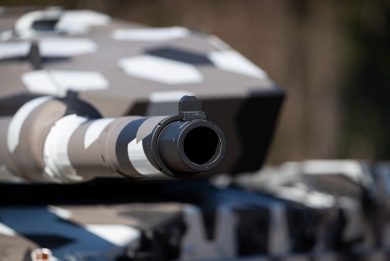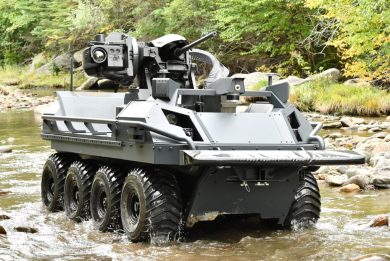Eurosatory 2024 – Rheinmetall/Lockheed Martin GMARS gets close to first firing
Looking for a successor of Germany MARS II multiple launch rocket system, the Bundeswehr designation of the Lockheed Martin MLRS, Rheinmetall and the US company are developing the GMARS, which demonstrator is exhibited for the first time at Eurosatory 2024
The new system demonstrator was unveiled at a ceremony at the Rheinmetall stand on the opening day of the Paris exhibition. The idea that led to the GMARS was to have the same firepower of an MLRS with a mobility on land equal to that of the HIMARS, the solution being to install the MLRS launcher over a truck, in this case an HX2 8×8 produced by Rheinmetall MAN Military Vehicles (RMMV) in its Vienna facility. Strategic mobility is a key factor when redeploying over long distances, and the need to use tank transporters to deploy the MLRS was not the best solution, those assets being required for transporting main battle tanks and infantry fighting vehicles.
However, the original two-pod launcher of the 3 metres wide MLRS overcomes the width limits of most European countries, usually 2.55 metres. In order to cope with European regulations and allow the GMARS to move on roads without the need of police escort Rheinmetall managed to reduce the space between the two rocket pods, bringing the width down to 2.5 metres, the same of the HX family of trucks, Marius Meyering Head of Sales of Rheinmetall explained to EDR On-Line.
The GMARS is 9.8 metres long and 3.9 metres high, these measures falling within civil traffic limitations. The two crew members are hosted in the armoured cabin, which can however accept a third passenger. Fully loaded the GMARS has a mass of 42,240 kg, while empty this is of 31,140 kg.
Coupling the launcher and the truck gives a solution capable to move for hundred kilometres on land without any problem, maximum speed on road being 100 km/h while range in nominal conditions is 700 km. The launcher retains the loading mechanism that makes the MLRS, and therefore the GMARS, autonomous, being capable to unload the empty pod and load the full one without needing an external crane. This allows reloading in dispersed areas without concentrating ammunition at the same place, a safety measure against enemy threats such as loitering munitions and weaponised UAS. According to Mr. Meyering the GMARS does not need outriggers to stabilise the vehicle during firing coupled to the inertial/GPS navigation system and fire control system, this allows reduced in battery-out of battery time, the latter of key to avoid counterbattery fire.
While it has a much greater mobility on land than the M270 MLRS tracked launcher, and the same of the M142 HIMARS wheeled launcher, when comparing it with the latter the GMARS is not capable to be transported by air on a C-130 class aircraft. Rheinmetall notes that this is mostly a US requirement, the United States being the only country capable to deploy by air a brigade-size formation, while the GMARS is designed mostly to answer European requirements, now that the Old Continent is facing again a threat from the east. Having twice the firepower of a HIMARS was therefore considered of greater importance than air deployment capability, the speed and range on roads ensuring quick deployment even at a few thousand kilometres, distances that may be encountered in the European scenario.
Commenting the company decision to go with Lockheed Martin for developing the future multiple rocket system for the German Bundeswehr, Marius Meyering noted that two main reasons were considered; the first is that Lockheed Martin is the market leader in the NATO environment, the second being that the US company is the only one that has a munition with an over 500 km range ready to be used, missiles of shorter ranges being also economically attractive mass-produced allowing to lower their cost.
The GMARS will be capable to fire all the munitions developed by Lockheed Martin for its MLRS/HIMARS system, hence the 70 km range GMLRS, available both with Unitary and Alternative warheads, the ER GMLRS extended range version with a 150 km range, the MGM-140 ATACMS with a 300 km range, and finally the Precision Strike Missile (PrSM) which range exceeds 500 km. Of course, the number of munitions per pod varies, with 6 each for the GMLRS and ER GMLRS, 1 for the ATACMS and 2 for the PrSM. Rheinmetall and Lockheed Martin do not consider adding third party munitions to those already available, which would require a US Government clearance that might never come. Looking at the future two possible additional ammunition might be adopted, a surface-launched cruise missile with a 370 km range and 122 mm rockets with 22 km range, no data on the number of effectors contained by a single pod being announced.
The two companies are getting ready for the first firing of the GMARS, which will take place late this year at the US Army White Sands Missile Range in New Mexico, USA, and will be attended by numerous US and foreign delegations.
Marius Meyering considers this an opportunity to show not only the new multiple rocket launcher system, but also to highlight the qualities of the carrier, the HX family of trucks being proposed by American Rheinmetall Vehicles and GM Defense for the US Army Common Tactical Truck (CTT) programme. The Army aims fielding the first CTT trucks in 2028, the aim being the M915 Line Haul Tractor, M1088 Medium Tractor, Palletized Load System and Heavy Expanded Mobility Tactical Truck part of the service tactical vehicle fleet.
Photos by P. Valpolini







